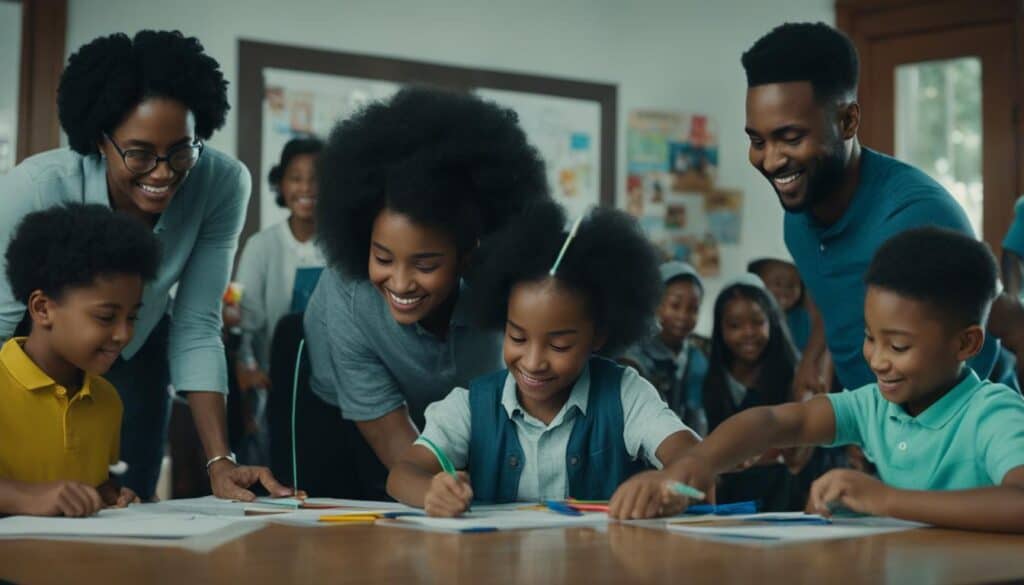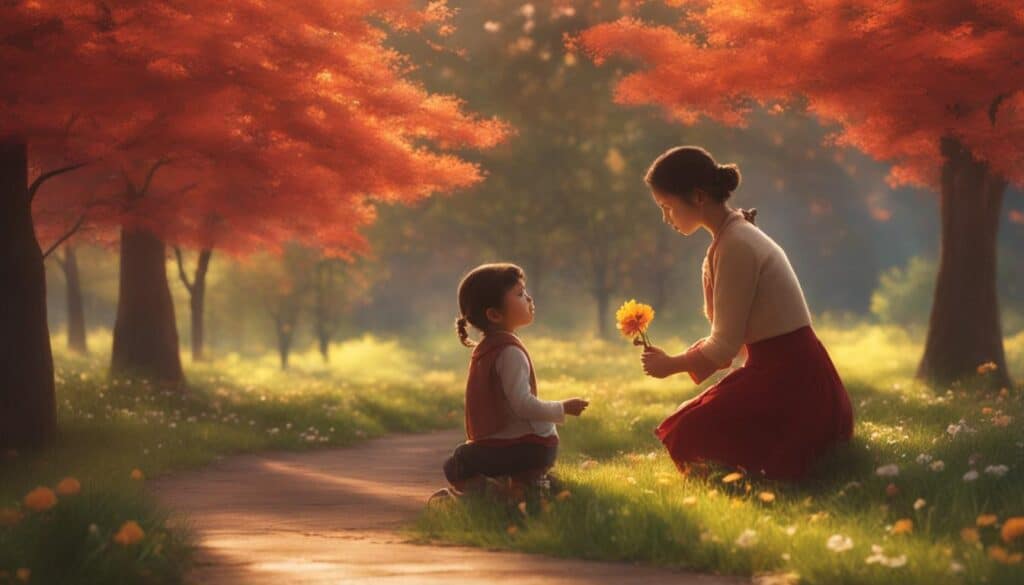When it comes to raising children, every parent wants to instill essential life skills and values that will empower their little ones to navigate life with confidence and success. Positive discipline is a parenting approach that focuses on nurturing empowered children by teaching them responsibility, self-discipline, and problem-solving skills.
This article will delve into the principles of positive discipline and explore how it can be effectively applied to raise empowered and responsible children. By understanding the difference between enabling actions and empowering actions, parents can create an environment that fosters the growth and development of their children.
Key Takeaways:
- Positive discipline focuses on empowering children to manage themselves.
- Enabling actions hinder the development of responsibility and self-discipline.
- Empowering actions give children the power to make decisions and learn from mistakes.
- Positive discipline can be applied in various situations and challenges.
- Building strong connections and effective communication are paramount in positive discipline.
Understanding Positive Discipline

Positive discipline is a parenting approach that prioritizes empowering children and giving them control over their own lives. It goes beyond controlling or rescuing children and focuses on helping them develop responsibility, self-discipline, and problem-solving skills. Unlike enabling actions and statements that minimize the consequences of children’s choices, positive discipline emphasizes empowering actions and statements that enable children to manage themselves.
Positive discipline involves understanding the difference between enabling actions and statements that hinder children’s development and empowering actions and statements that give children the power to make decisions. By embracing empowering actions and statements, parents can foster their children’s independence and self-confidence, paving the way for them to become responsible and resilient individuals.
Implementing positive discipline requires a deep understanding of the principles and strategies involved. It involves leveraging effective communication, setting boundaries, and allowing children to experience the natural consequences of their choices. Positive discipline is a fundamental tool for parents looking to raise empowered and responsible children.
Stay tuned for the next section, where we will dive deeper into enabling actions and statements and how they can hinder children’s development.
Enabling Actions and Statements

Enabling actions and statements can hinder the development of responsibility and self-discipline in children. These actions and statements involve doing things for kids that they are capable of doing themselves, such as completing their chores or homework. By doing too much for them, parents unintentionally prevent children from learning important life skills and experiencing the natural consequences of their choices.
Enabling actions can take various forms, including bailing children out after reprimanding them for their mistakes, buying them everything they want to avoid disappointment, and using bribes and rewards to control their behavior. Similarly, enabling statements may involve lying for them, punishing and controlling their decisions, or blaming and shaming them, which undermines their sense of accountability.
Enabling actions and statements do not empower children; instead, they give them too much and deny them valuable opportunities for personal growth and learning.
By giving children too much, parents inadvertently hinder their ability to become self-sufficient and responsible individuals. Overprotecting and hovering over children can stifle their independence and prevent them from developing problem-solving skills. Shielding them from the consequences of their actions may temporarily relieve their discomfort, but it fails to teach them how to handle challenges and face the consequences of their choices in the long run.
Positive discipline encourages parents to recognize and address enabling actions and statements. By fostering an environment that promotes responsibility and self-discipline, parents can help children navigate challenges, make informed choices, and develop a sense of accountability for their actions.
Examples of Enabling Actions and Statements:
- Completing tasks or chores for children that they can do independently.
- Rescuing them immediately after reprimanding them, without allowing them to learn from their mistakes.
- Purchasing everything they want, without teaching them the value of money and delayed gratification.
- Using bribes and rewards to control their behavior, rather than fostering intrinsic motivation.
- Overprotecting and hovering, preventing them from developing problem-solving skills.
- Lying for them, avoiding consequences and hindering their honesty.
- Punishing and controlling their decisions, instead of allowing them to make choices and learn from the outcomes.
- Blaming and shaming them, which damages their self-esteem and stifles their sense of responsibility.
Empowering Actions and Statements

Empowering actions and statements play a crucial role in positive discipline, as they allow children to take charge of their own lives and decisions. By relinquishing control and providing support, parents can foster the development of self-discipline and responsibility in their children.
- Show faith in their abilities: Acknowledge your child’s capabilities and believe in their potential. By expressing confidence in their skills, you empower them to take on challenges and make their own choices.
- Respect their privacy: Recognize that children also need personal space and boundaries. Encourage open communication, but respect their need for privacy when they do not want to discuss certain topics.
- Express your limits: It’s important to set boundaries and express your limits as a parent. By communicating your expectations clearly and enforcing them consistently, you provide a sense of structure and guidance.
- Listen without fixing or judging: Give your child the opportunity to share their thoughts and feelings without rushing to offer solutions or passing judgment. By actively listening, you show that their opinions and emotions are valued.
- Control your own behavior: Model the behavior you want to see in your child. By demonstrating self-control, respect, and empathy, you teach them how to navigate challenging situations with maturity.
- Allow them to decide what they will do: Encourage autonomy by involving children in decision-making processes. Let them have a say in matters that directly affect them, fostering a sense of ownership and responsibility.
- Let go of their issues: Avoid solving all of your child’s problems for them. Instead, guide them in finding their own solutions. By allowing them to face challenges and learn from their mistakes, you empower them to develop problem-solving skills.
- Encourage them to ask for help: Foster a supportive environment where asking for help is encouraged. Teach your child that seeking assistance is a sign of strength and resourcefulness, rather than a sign of weakness.
By implementing these empowering actions and statements, parents can create a nurturing and empowering environment for their children. This approach allows children to develop their decision-making abilities, learn from their mistakes, and cultivate self-discipline.
Practical Strategies for Positive Discipline

Parenting with positive discipline involves implementing practical strategies that promote self-discipline, problem-solving skills, and a sense of responsibility in children. These strategies can be applied in various situations and challenges, ensuring a nurturing and empowering environment for your child’s development.
Here are some examples of practical strategies for positive discipline:
-
- Using empowering statements:
When dealing with neglected homework or tasks, use encouraging and empowering statements to motivate your child. For example, say, “I believe in your ability to complete this task. How can I support you?” This approach fosters a sense of responsibility and ownership in your child, encouraging them to take action.
-
- Respecting privacy:
Children may not always want to discuss their problems or issues immediately. Respect their need for privacy and create a safe space where they feel comfortable opening up when ready. This approach builds trust and allows them to develop their problem-solving skills.
-
- Expressing your limits:
While it’s essential to support your child, it’s equally important to express your limits. If they continually rely on you to bail them out of challenging situations, explain that you have your own boundaries and cannot always solve their problems for them. This empowers them to find their own solutions and take responsibility for their actions.
-
- Listening without judgment:
When your child wants to share their feelings or experiences, be a non-judgmental listener. Avoid interrupting or criticizing their emotions. Instead, provide a safe space for them to express themselves openly, which strengthens your bond and teaches them the importance of effective communication.
-
- Deciding on mutually agreed-upon solutions:
Involve your child in joint problem-solving. When conflicts or disagreements arise, discuss possible solutions and encourage them to actively participate in finding a resolution. This approach helps them develop critical thinking skills, problem-solving abilities, and a sense of responsibility for their choices.
By employing these practical strategies in your positive discipline parenting approach, you can empower your child to develop self-discipline, make thoughtful decisions, and become a responsible and confident individual.
Positive Discipline for Teenagers

Parenting teenagers can be challenging, but with positive discipline, you can create an environment that fosters their growth and development. Positive discipline emphasizes guiding and empowering teenagers to make responsible choices rather than imposing strict rules. By focusing on respectful communication, letting go of their issues, and guiding them in problem-solving, positive discipline helps teenagers develop self-discipline, critical thinking skills, and a strong sense of responsibility.
One key aspect of positive discipline for teenagers is creating agreements instead of rules. Agreements involve open discussions and mutually agreed-upon expectations, allowing teenagers to feel a sense of autonomy and ownership. This collaborative approach helps them understand the reasons behind certain boundaries and encourages them to make thoughtful decisions.
Respectful communication is another essential component of positive discipline. By listening empathetically without judgment, parents can foster a trusting and open relationship with their teenagers. This creates a safe space for teenagers to express their thoughts, feelings, and concerns, promoting healthy communication and problem-solving.
Letting go of their issues is also important in positive discipline for teenagers. It means allowing them to face the consequences of their actions and learn from their mistakes. This helps teenagers develop resilience, accountability, and problem-solving skills, enabling them to navigate challenges and make better choices in the future.
In summary, positive discipline provides a framework for parenting teenagers with empathy, respect, and guidance. By focusing on creating agreements, fostering respectful communication, and allowing for growth and problem-solving, parents can help their teenagers develop self-discipline, critical thinking skills, and a strong sense of responsibility.
The Importance of Empowerment in Children

Empowerment is crucial for children’s personal and social development. When children feel empowered, they become more confident, responsible, and capable of making their own decisions. Empowered children are more likely to take ownership of their actions and strive for success. Empowerment helps children develop a positive self-image and prepares them for a successful future.
Children who lack empowerment may struggle with low self-esteem, indecisiveness, and a lack of initiative. By empowering children, parents and caregivers can foster their independence and nurture their potential. This involves providing opportunities for children to make choices, solve problems, and take on age-appropriate responsibilities.
Empowering children can be achieved through various means, such as:
- Encouraging their participation in decision-making processes within the family
- Supporting their interests and passions
- Allowing them to take on tasks and responsibilities, such as chores or managing personal finances
- Listening actively to their opinions and ideas
- Teaching them problem-solving and critical-thinking skills
- Providing opportunities for them to learn new skills and build competence
Empowerment in children also involves promoting a positive mindset and resilience. Parents can help their children develop a growth mindset by emphasizing effort, perseverance, and learning from failures and setbacks. By teaching children to view challenges as opportunities for growth, parents can empower them to overcome obstacles and develop resilience.
“Empowering children is not about making them feel entitled or above others. It is about equipping them with the tools and mindset necessary to navigate the complexities of life, make informed decisions, and contribute meaningfully to society.” – Dr. Emma Johnson, child psychologist
Empowerment is a continuous process that requires ongoing support and guidance from parents and caregivers. Through empowerment, children can develop essential skills, strengthen their sense of self-worth, and become resilient individuals capable of making a positive impact on their own lives and those around them.
Building Connection and Communication

Positive discipline emphasizes the importance of building strong connections and effective communication with children. When parents establish a deep bond with their children, it creates a solid foundation for a positive parent-child relationship. Effective communication plays a vital role in understanding children’s needs, validating their feelings, and creating a safe and supportive environment.
One way to foster connection and communication is through family meetings. These meetings provide an opportunity for everyone in the family to contribute and problem-solve together. By involving children in decision-making processes, parents can empower them and promote their sense of responsibility. Family meetings also serve as a platform for open dialogue and encourage effective communication.
In addition to family meetings, curiosity questions are a powerful tool for engaging children in meaningful conversations. By asking open-ended questions that encourage critical thinking, parents can stimulate their child’s problem-solving skills and help them find their own solutions. Curiosity questions show a genuine interest in the child’s thoughts and feelings and create a space for open communication.
“Effective communication is not just about speaking, but also about actively listening to your child. Validate their feelings and let them know that their opinions matter. When children feel heard and respected, it strengthens the bond between parent and child.”
Building connection and effective communication is an ongoing process that requires time, effort, and patience. By prioritizing open dialogue, understanding, and empathy, parents can foster a positive and supportive environment that nurtures their child’s development.
The Role of Kindness and Firmness

In positive parenting discipline, being both kind and firm plays a crucial role in raising empowered and responsible children. Kindness involves validating children’s feelings, showing empathy, and providing support. By acknowledging and understanding their emotions, parents create a safe and nurturing environment where children feel heard and understood.
Firmness, on the other hand, entails setting clear boundaries, enforcing consequences, and holding children accountable for their actions. It establishes structure and discipline, helping children develop a sense of responsibility and self-discipline. By consistently upholding boundaries and enforcing consequences, parents teach children about the importance of making mindful choices and taking responsibility for their behavior.
By embodying both kindness and firmness, parents strike a balance between nurturing and guiding their children. It is important to show love, respect, and support while also teaching them valuable life skills. Being kind and firm enables children to feel loved and valued while learning the necessary tools to navigate the world.
Teaching Responsibility and Self-Discipline

Positive discipline is a powerful tool for teaching children responsibility and self-discipline. It goes beyond simply controlling their behavior and focuses on helping them understand the consequences of their choices.
By implementing positive discipline techniques, parents can guide their children towards taking ownership of their actions and making thoughtful decisions. One effective technique is using natural and logical consequences that allow children to experience the direct outcomes of their behavior.
For example, if a child repeatedly forgets to complete their homework, a natural consequence would be receiving a lower grade. This teaches them the importance of being responsible and completing their assignments on time.
Another technique is problem-solving, where parents encourage their children to find solutions to their own challenges. This fosters their decision-making skills and helps them develop a sense of self-discipline.
Additionally, collaborative decision-making plays a key role in teaching responsibility and self-discipline. By involving children in the decision-making process, parents empower them and enable them to take responsibility for their choices.
Through these positive discipline techniques, children learn to evaluate the outcomes of their actions, understand the importance of responsibility, and develop self-discipline. This equips them with essential life skills that will serve them well throughout their lives.
By teaching responsibility and self-discipline, parents provide their children with a strong foundation for success. They learn to navigate challenges, make informed decisions, and take responsibility for their actions, ultimately shaping them into confident and independent individuals.
Dealing with Power Struggles

If you’re a parent, you’ve likely experienced power struggles with your child at some point. These battles for control can be frustrating and draining. However, positive discipline offers effective strategies to help you navigate and manage power struggles in a healthy way.
Understanding the underlying reasons for power struggles is key to addressing them effectively. Your child may be seeking attention, trying to assert their power, seeking revenge, or even giving up. By recognizing these motivations, you can approach the situation with empathy and understanding.
One technique of positive discipline is the use of family meetings. These meetings provide a safe space for everyone to express their thoughts and concerns, fostering open communication and problem-solving. By involving your child in decision-making and conflict resolution, you can defuse power struggles and encourage cooperation.
Respectful communication is another important aspect of positive discipline when dealing with power struggles. By actively listening to your child and validating their feelings, you create an environment of mutual respect and understanding. This helps prevent conflicts and allows for meaningful resolutions.
Problem-solving is a valuable skill to teach children during power struggles. Encourage your child to think critically and find solutions to the challenges they face. This approach empowers them to take responsibility for their actions and develop effective problem-solving skills.
Remember, positive discipline is not about winning the power struggle or exerting control over your child. Instead, it focuses on fostering cooperation, mutual respect, and a healthy parent-child relationship. By using these strategies, you can defuse power struggles and create a positive and empowering environment for your child to thrive.
Nurturing Self-Esteem and Confidence

Positive discipline is not only about managing behavior but also about nurturing your child’s self-esteem and building their confidence. By using empowering actions and statements, parents can create a supportive environment that fosters healthy self-image and belief in their child’s abilities.
Encouragement is a powerful tool in positive discipline. By acknowledging your child’s efforts and progress, you help them develop a sense of pride and motivation. Offer specific praise that highlights their strengths and accomplishments, such as “I’m impressed by how determined you were to finish your project.”
In addition to praise, focusing on strengths can also contribute to building confidence. Help your child identify and develop their areas of interest and natural talents. This not only boosts their confidence but also enables them to explore their passions and develop a sense of purpose.
It’s important to remember that self-esteem and confidence are built over time through consistent and nurturing interactions. Be present and attentive to your child’s emotional needs, listen to their thoughts and feelings, and provide a safe space for them to express themselves freely.
Positive discipline techniques also involve setting realistic expectations and allowing your child to take appropriate risks. Encouraging them to try new things and supporting them even when they make mistakes sends the message that they are capable and resilient.
As your child develops a positive self-image and grows in confidence, they will be better equipped to face challenges, make choices that reflect their values, and navigate the complexities of life with resilience and optimism.
Learning from Mistakes and Failure
Positive discipline acknowledges the significance of children learning from their mistakes and experiencing failure. Rather than resorting to punishment or shame, positive discipline encourages children to reflect on their choices, take accountability, and seek out solutions. By embracing mistakes as opportunities for growth and providing unwavering support and guidance, parents can help foster resilience, develop problem-solving skills, and instill a growth mindset in their children.
Resilience is a key component of positive discipline, enabling children to bounce back from setbacks and challenges. It teaches them to embrace failure as a stepping stone to success and encourages them to persevere in the face of adversity. By guiding children to learn from their mistakes and develop resilience, parents equip them with the tools necessary to navigate life’s obstacles and emerge stronger and more resilient individuals.
The Journey of Positive Discipline
Positive discipline is not a quick fix but rather a transformative journey of continuous learning and growth for both parents and children. It requires consistency, patience, and a commitment to modeling positive behavior. Through ongoing practice and refinement of effective child discipline strategies, parents can create a nurturing and empowering environment that supports their children’s development of responsibility, self-discipline, and resilience.
Parenting with positive discipline is an intentional choice to empower children and help them become capable, confident individuals. It involves understanding the principles of positive disciplining and applying them consistently in everyday situations. By promoting self-awareness, empathy, and effective communication, parents can foster a positive parent-child relationship built on trust and mutual respect.
The positive discipline journey is not without its challenges, but with dedication and perseverance, parents can navigate them successfully. It requires adapting strategies to suit the unique needs and personalities of each child, while still maintaining clear boundaries and expectations. The journey of positive discipline is an opportunity for parents to grow alongside their children, learn from mistakes, and discover the immense rewards of raising empowered and responsible individuals.
In conclusion, parenting with positive discipline is an ongoing journey that requires patience, consistency, and an unwavering commitment to creating a supportive and empowering environment for children. By implementing effective child discipline strategies and modeling positive behavior, parents can help their children develop the skills and values necessary for a successful and fulfilling life. The positive discipline journey is not always easy, but it is undoubtedly worth it, as it paves the way for the growth and well-being of both parents and children.
 Fullersears
Fullersears





